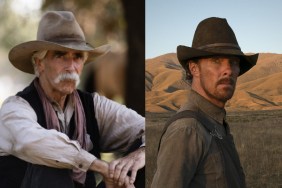
Another gay icon from the 1950s is easily Plato, the tragically murdered sidekick to James Dean’s character in the famous 1955 classic Rebel without a Cause. Played by Sal Mineo, a gay man, Plato latches onto Jim (Dean) with a romantic fervor. His interest and fascination with Jim is certainly more than just friendly. It’s posited in dialogue that Jim is meant to be the father that Plato always wished he had, but it could just as easily be seen as the lover that he’s too afraid to pursue. Plato also has a picture of Alan Ladd in his locker. Hm… That Plato is killed at the film’s end is only seen as a tragic end to a sad character. This was common in a lot of later films. If a character was clearly or even vaguely gay, they would have to be punished in some way. Usually killed.
The same thing can be seen in the 1959 film Suddenly Last Summer, wherein an offscreen character named Sebastian is implied to be a hustler who uses Liz Taylor and Katherine Hepburn to lure boys to his side. Sebastian is seen in a flashback (with his face away from the camera) being chased and killed by an angry mob (the echoes of Bride of Frankenstein are pretty clear). In a way, Sebastian may be seen as the ultimate symbol for all gay characters in movies up to that point. No identity beyond his sexuality. No voice to speak. A tragic figure whose sexuality is something to lament. And, ultimately, a victim of hate. A martyr? Perhaps not. Just a tragic figure.

The only gay figures that really breathed during the 1950s were either the coded ones (Doris Day’s Calamity Jane comes to mind), the outright exploitation lesbians (women in prison films started in the 1950s), or the comedic stereotypes played by Rock Hudson. One of the best lines in all cinematic history comes at the end of Billy Wilder’s 1959 film Some Like it Hot, which is, when thought about for a moment, an open admonition of bisexuality. It’s played for laughs, but the implication is there. I won’t tell you what the line is, just in case you don’t know. I’m not going to be the one to ruin that one for you.
Throughout the 1960s, gay visibility increased, but to a tragic degree. Gay characters would crop up – coded and otherwise – to have strong romantic feelings, only to be cut down by violence and suicide. One can see this new form of tongue-clucking pity as perhaps an upward move from outright derision (it is, at least, an increase in visibility: the love that dare not speak its name is finally speaking its name a little bit), but it’s certainly not much of an improvement. You look at movies like 1961’s The Children’s Hour, clearly about the shameful lesbian love that Shirley MacLaine has for Audrey Hepburn, and see nothing but weeping and suicide. You think of the infamous bath scene from Stanley Kubrick’s 1960 epic Spartacus, wherein Laurence Olivier admits, through an oyster-and-snail metaphor, that he is bisexual, and realize that is was cut from the original edit of the film. In 1968’s Frank Sinatra vehicle The Detective, we see a closeted gay detective going to gay bars, talking with gay men, and feeling increasingly filthy because of it. These characters are all pitiful and sad and tragic in their ways. Whenever sexuality was broad and funny (or just plainly pornographic), it was fine. If it was a serious crux of drama, or a realistic part of a whole character, it was cut and eschewed.
Yes, there are the works of Kenneth Anger going on at this time, but he was hardly mainstream. He made important movies, but there were considered (and are still considered) “underground.” He was open about homosexuality, but he was widely seen by mainstream audiences.

In 1961, the cinematic tables began to turn in earnest with a British film called Victim, starring Dirk Bogarde. Victim is perhaps the first mainstream movie to feature a gay main character who is seen as heroic. Bogarde plays a closeted gay lawyer who is being blackmailed about his sexuality. Blackmail was, in those days, often called “the gay crime,” as it was often used to extort money from gay men who didn’t want to be outed. Victim deals with the notion of outing gay men in a modern society, and depicts the blackmailer – and not the gay man – as the depraved villain. Victim was a British film, and didn’t get the splash an American release might have, but it did represent a turning point in queer cinema. The 1960s saw more and more gay characters, and while some were only incidentally gay, most were still struggling through the “pitiful” and “slapstick” phases.
But something would happen in 1969 that would change everything. The Stonewall riots brought gay visibility to the fore, and the movies began to reflect that. Next week, I will be talking about queer cinema of the 1970s, how earnest gay romance began to take shape in the 1980s, and the indie boom of the 1990s that exploded queer cinema into a legitimate genre of film. Until then, stay alert, alive, and in love, my friends.
Homework for the Week:
What was the first gay character you saw in a movie? How often are you aware of gay characters? Does their sexuality mean anything to the story? How do you think older movies depict sexuality? Are gay people ever positive role models in movies? How clear is homosexuality in certain older movies?
Witney Seibold is a featured contributor on the CraveOnline Film Channel, co-host of The B-Movies Podcast and co-star of The Trailer Hitch. You can read his weekly articles B-Movies Extended, Free Film School and The Series Project, and follow him on “Twitter” at @WitneySeibold, where he is slowly losing his mind. If you want to buy him a gift (and I know you do), you can visit his Amazon Wish List.







